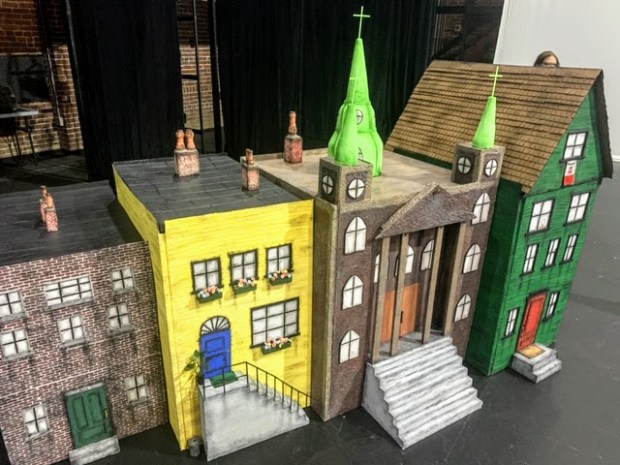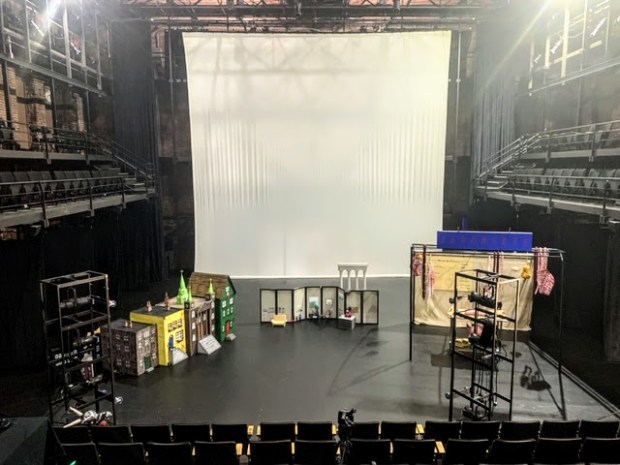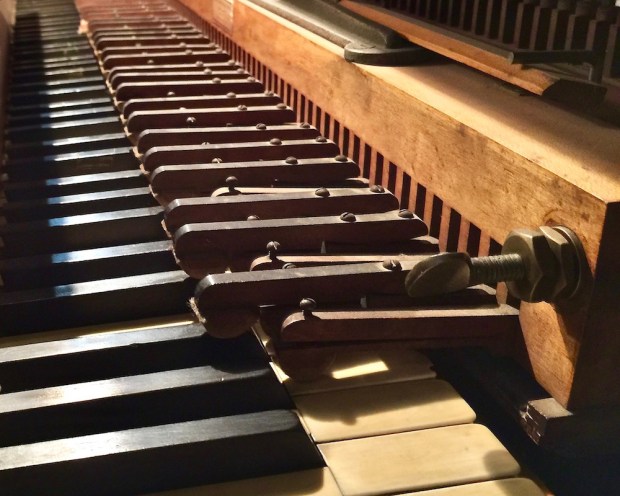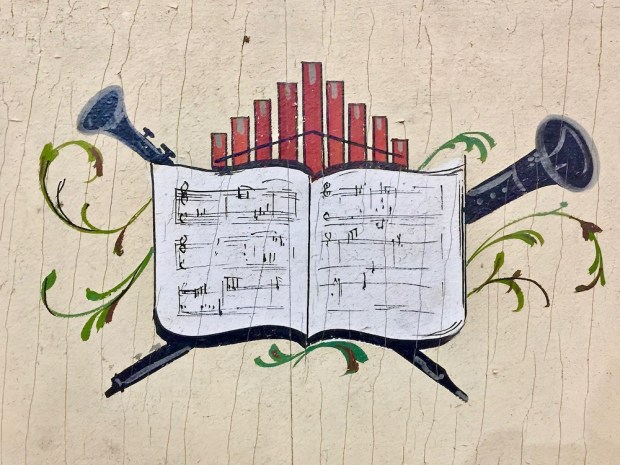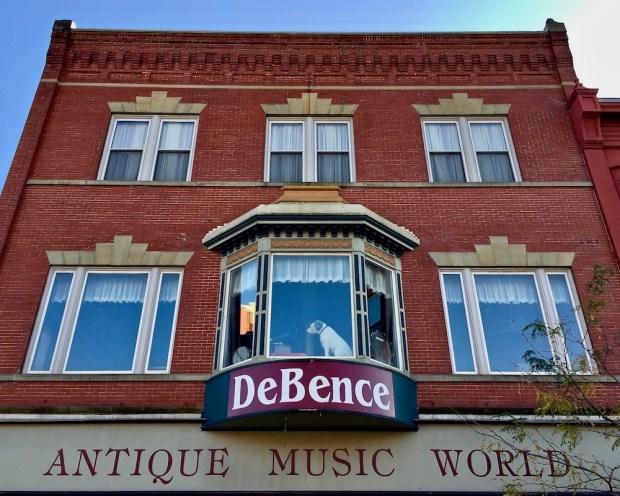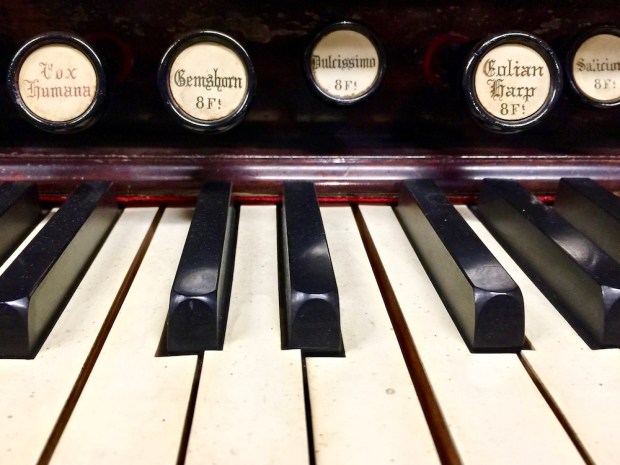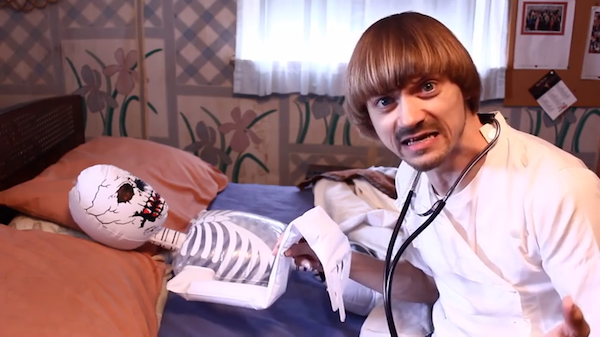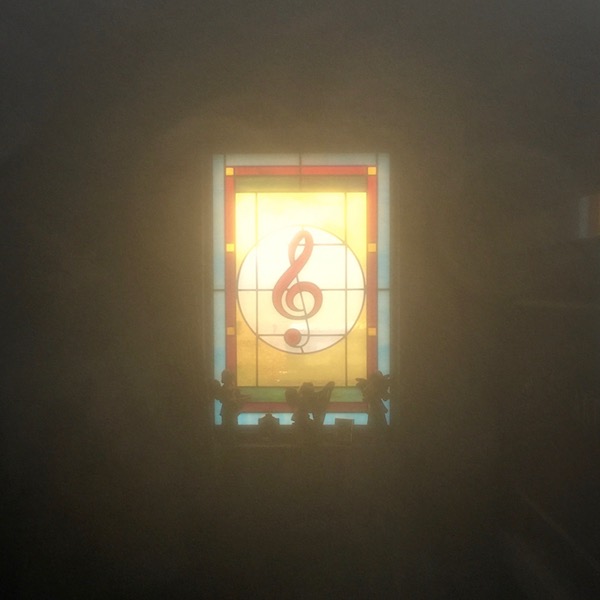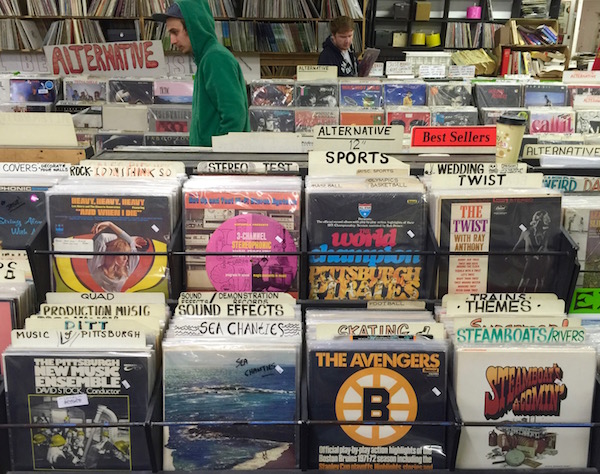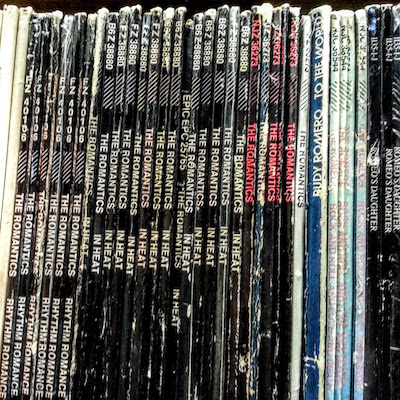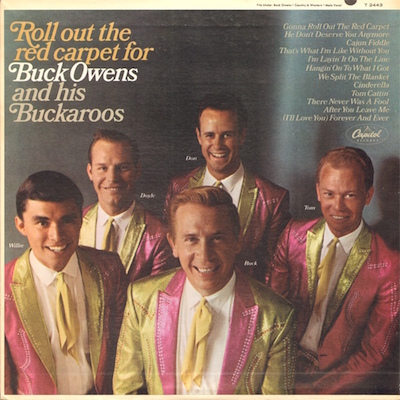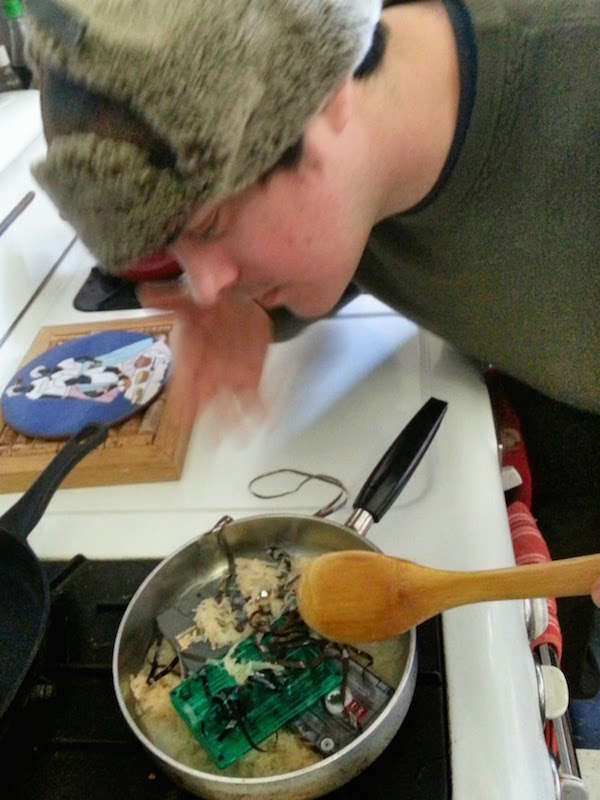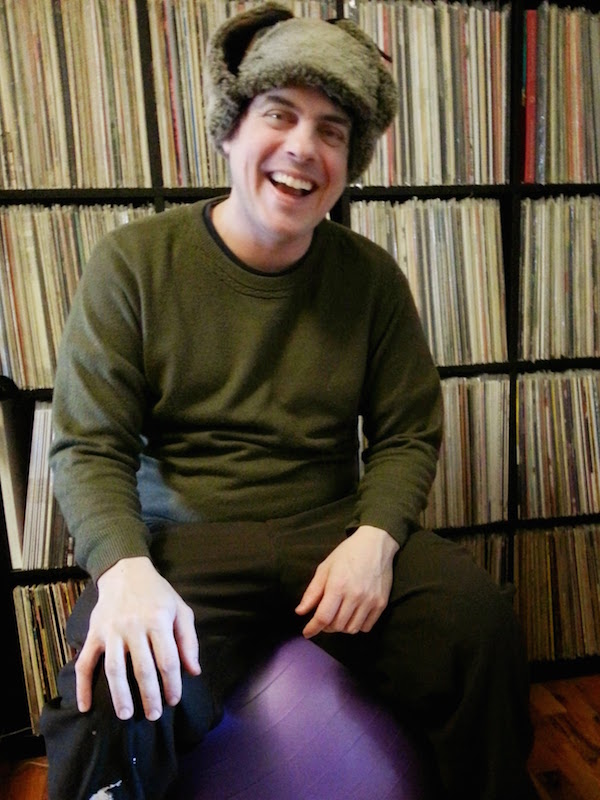
KISS super collector Bruce Gleason in his New Kensington home
The collection is called The Elder’s Closet of Heroes. One enters through a short half flight of steps, past walls of signed album covers from the likes of Heart and Linda Ronstadt, Belinda Carlisle and Cher. This alone would be an impressive attraction for the memorabilia-curious but for the imposing, intriguing, and attention-grabbing feature mere feet away at the foot of the steps.
The stout wooden door looks like it came from another world. It is a standard size for an interior space in the quaint, pre-war bungalow that houses it, but everything else about the structure suggests the darkest depths of Mordor or a final line of defense against banshees.

What a knocker! Entrance to Gleason’s KISS collection modeled on album cover art for “Music from ‘The Elder'”
The door is strengthened with gridlike cross braces, an array of irregular brass tacks hammered in for folksy verisimilitude. The giant ornate iron knocker is placed just so, where the visitor’s first visual detail is an inscribed brass plaque with a verse from a KISS song called “A World Without Heroes” from their 1981 album Music from “The Elder”:
A world without heroes
Is like a world without sun
You can’t look up to anyone
Without heroes.

cover art for KISS’s 1981 album “Music from ‘The Elder'”
KISS, the bombastic stadium rock act whose over-the-top antics and Kabuki-meets-Stan Lee stage personas helped define American popular culture in the 1970s, is still going strong today. For the past four-and-a-half decades, the band is also likely the most merchandised musical group to ever accept your Visa or Mastercard. There are KISS-branded t-shirts, posters, books, and concert videos, of course, but the marketing goes way beyond the standard collection of musical ephemera.
Over the years, you could purchase KISS garbage cans, flying model rockets, bubble gum trading cards, and a knock-off Rubik’s Cube. There was a KISS pinball machine made by Bally in 1979; a KISS board game, checkers set, and jigsaw puzzle from the years prior. There are KISS sneakers, bedspreads, pillowcases, neckties, and sunglasses. If one wanted a giant teddy bear made up like The Catman or Space Ace, that is available, as are KISS Pez dispensers, lava lamps, die-cast miniature stock cars, HO scale model railroad trains, and a LEGO set depicting the band on stage.

Hello Kitty, meet The Catman
Not content to live in the past, KISS has totally gone totally Merch 2.0 with branded earbuds, thumb drives, mouse pads, and insulated travel mugs. Famous teetotalers both, Paul Stanley and Gene Simmons are happy to supply you with KISS wine, ornate German-style beer steins, champagne flutes, shot glasses, bottle openers, and beer koozies.
And then of course there are the figures of KISS band members. Like the superhero characters they’re modeled on, Paul, Gene, Ace, and Peter have been turned into collectable dolls/action figures from six inches in height to several feet tall; adorned in various faithful touring costume iterations; rocking out in concert stage sets and alone with their thoughts; mythologized as Grecian gods in ornamental busts and as faces carved into a mini-Mount Rushmore.
On the other side of that incredible entrance door, Bruce Gleason, KISS super collector, has every single one of these–and a whole lot more.*
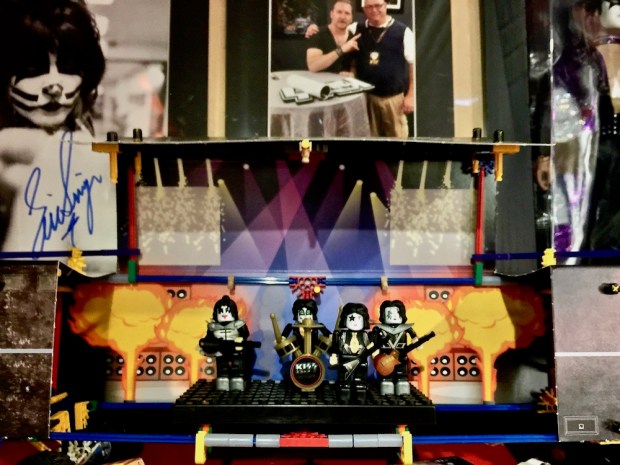
LEGO KISS stage set

Let’s put the “X” in Xmas: KISS ornaments
More precisely, Bruce has four of each. “The trouble with collecting KISS,” Bruce Gleason sighs, “Is that there’s never just one of anything–each band member has to get their own.”
While that’s not always the case–KISS M&Ms, condoms, and Christmas ornaments, for example, seem to be group-branded–for the most part it’s true. This results in many linear feet of Bruce’s basement shelf space, repurposed retail display racks, and enormous grab baskets devoted to individually-packaged figures nestled neatly side-by-side like the world’s most specialty of oddball boutiques.

KISS figures, Matchbox cars, soft blocks

one of two baskets overflowing with KISS plush toys
The packaged/made-for-the-collector’s-market items are impressive for both their volume and breadth [who knew the world needed KISS plush toys or a KISS skateboard?] but Bruce has a number of handmade pieces created by friends who understood how much he would appreciate them.
“My handmade pieces are my favorites,” Bruce says, “They’re all one-of-a-kind, but the most important reason is that friends have taken time to create something for me that I will absolutely love. I can purchase KISS items, which I love to do, but I can’t purchase someone’s creativity and thoughtfulness. These pieces are priceless to me.”
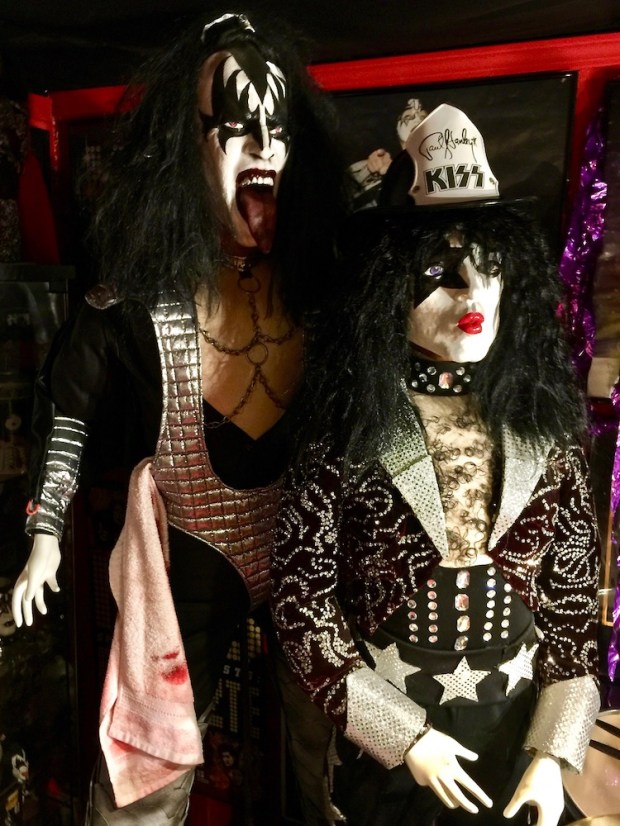
Plaster Casters: handmade, life size Gene Simmons and Paul Stanley figures
I haven’t met Bruce’s friends, but you can tell a lot about a person by the kinds of gifts he or she gives. You’ve got to love someone an awful lot to create all six-foot-something of a life-sized, tongue-waggling, codpiece-wearing Gene Simmons model or individually placing ersatz curly chest hairs on Paul Stanley’s likeness. Rest assured, full-size Ace and Peter, complete with the same tiny white repurposed jewelry model hands, are in Bruce’s basement as well.

handmade KISS nutcrackers
There’s a general truth that if it’s got a face, probably someone has slapped KISS makeup on it at some point. Let’s call it Beth’s Law.
That said, the handmade KISS nutcracker and marionette sets Bruce received from friends are truly some next-level fantasy-come-to-life. While they lack the sheer terror invoked by the trifecta of clown-like makeup, mannequins, and Gene Simmons, they make up for it in creativity and oddity.
Bruce tells us that KISS actually went on to market their own set of nutcrackers later on (surprise, surprise), but these predated that move. The marionettes are redecorated and bedazzled from a collection of puppets purchased in Mexico. The selection of Ace Frehley to be the one with the tequila bottle-turned-space beverage is a clever touch.

handmade KISS marionettes

handmade Gene Simmons marionette
This is all small potatoes compared to the elaborate big ticket items you’d expect to see in the Rock-and-Roll Hall of Fame … err, Hard Rock Cafe, at least. There are eight sets of giant silver and black platform boots–exact likenesses of KISS stage gear for two different costume iterations; a dozen signed, framed replica gold albums; cymbals and drumsticks; Paul Stanley and Gene Simmons limited edition electric guitars.
“I would love to own an original record player from the ’70s in mint shape,” Bruce tells us, “I have seen them but have never let myself justify spending the amount of money they are worth. Other things I’d love to have: an original pinball machine and an original Ace Frehley signed guitar. His is the only signed guitar I do not have.”
Bruce goes on to say that he doesn’t actually have room in the basement for a pinball machine [your author can attest to this] and he’s got a strict rule that the collection doesn’t breach the main living floor of his house.

Strutter: Gleason’s collection replica platform boots
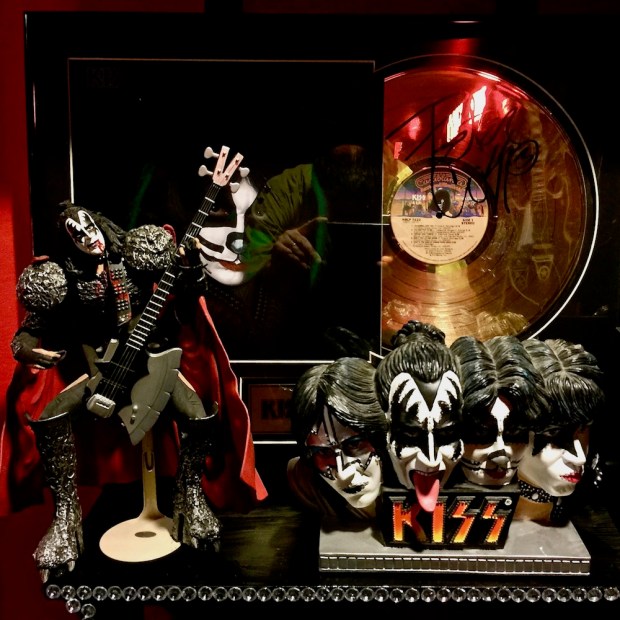
KISS collectables including signed gold record, Gene Simmons figurine, and four-headed ornament
Asked about his hopes for the collection, Bruce shares a dream that seems to cross all fandom–to be able to meet one’s heroes as equals:
My hope for my collection is that those who have seen it can appreciate the collection for what it shows and not what’s included–and that’s my love for this group of guys who have been a huge part of my life. They have given me my sparks of creativity, my love for music of all kinds, my love of live music, and that’s it’s OK to be different and unique as long as you’re being yourself.
I would love for Gene, Tommy, Eric Singer, Eric Carr, Paul, Ace, Bruce and Peter–all eight–to take a walk through my stage, without their boots, costumes, and makeup, just as eight regular guys. Then sit around my table and let me point out the things–toys, records, posters, or whatever–that meant something very special to me at the time and why.

Dark Light: rotating KISS lamp
It’s been said that one spends the first half of his or her life acquiring things and second half trying to get rid of them. On the ride home, Bruce’s ultimate fan archive sparked a, dare I say, existential conversation about the nature of collecting.
Why do we collect? Is the enjoyment in the possession or is it in the chase? Who do we share the collection with? What do we hope will happen to all our stuff?
Heavy questions, indeed, and not ones we’ll answer here. But if there’s anything that KISS can teach us it’s that you go big or go home. And, sweet Jesus, if you’re going big, you’d better shout it out loud.
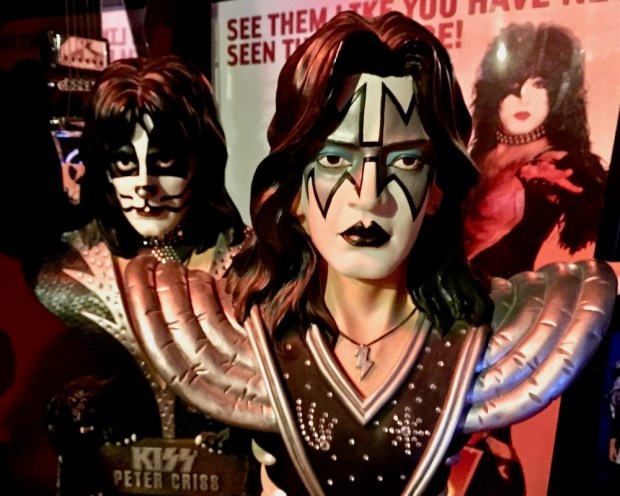
Watchin’ You: busts of Ace Frehley and Peter Criss
The Collectors is a new series documenting people with extraordinary personal collections. If you are, or know of, someone with an interesting set of stuff, we’d love to know about it.
* Bruce doesn’t actually own one of the KISS pinball machines–more about this later in the piece.





